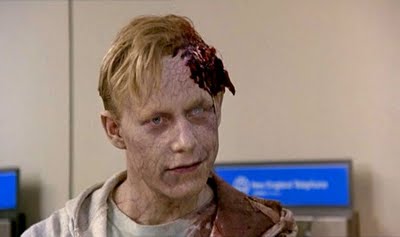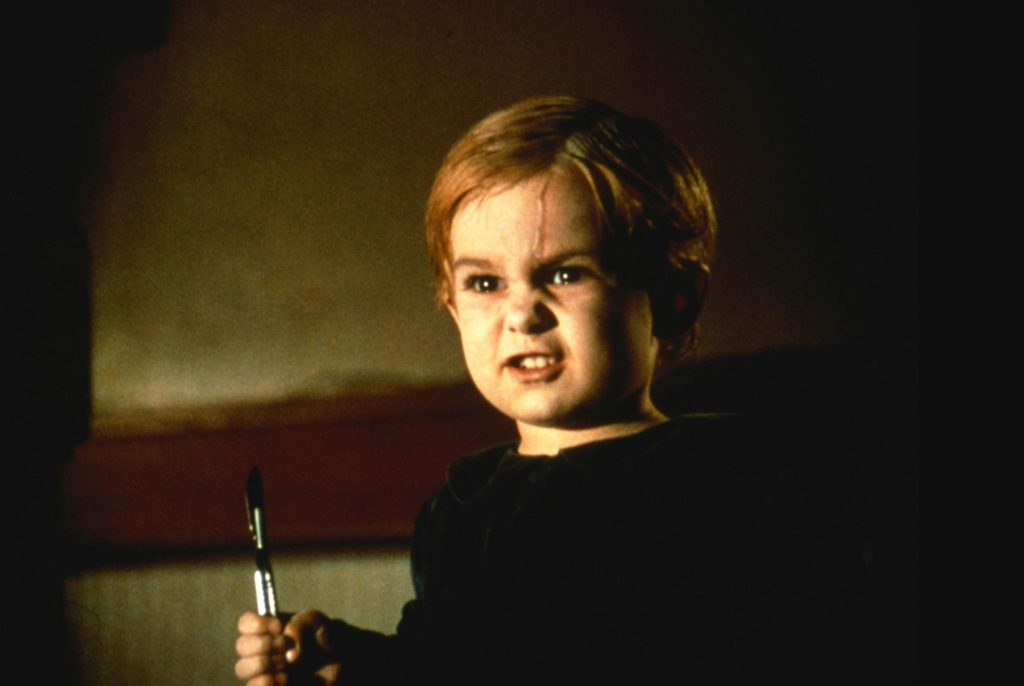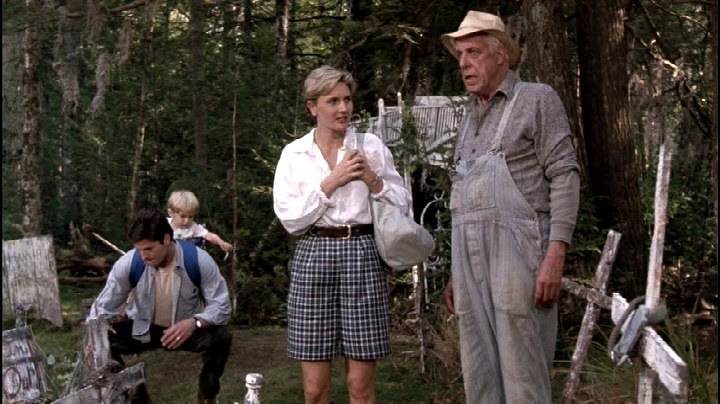
“What’s the buzz, Sister Honey.” Not enough bee humour in The Wicker Man, to be quite honest.
This January, in support of the Toronto Rape Crisis Centre / Multicultural Women Against Rape, friends and family have raised over $1,000, which means I have to watch and write about thirty-one horror movies. I’ll watch (on average) one movie a night, many of them requested by donors, after which I’ll write some things about said movies on this website. Be forewarned that all such write-ups will contain spoilers! The latest film I watched was the 2006 remake of The Wicker Man, directed by Neil Labute (Nurse Betty, In the Company of Men). The film, known more for Cage’s meme-able manic performance than for any real scares, was not explicitly suggested by anyone, but I attended several hours of friend and Nicolas Cage expert Lindsay Gibb’s New Year’s Day 24-Hour Nic Cage Marathon, and it was one of the few films of the actor that could be defined as horror. (Check out her excellent book-length defence of Nicolas Cage, National Treasure (ECW Press).
What happens:
Many readers may be familiar with the original The Wicker Man (1973), in which a police officer is called to a remote Scottish island to investigate the disappearance of a local girl. It’s a film which has the distinction of being the creepiest movie shot almost entirely in daylight. The remake moves the action to America’s Pacific Northwest, but – with some notable exceptions – preserves many of the key plot points, if not the unsettling atmosphere.
Before the film’s credits even roll, we spot Edward Malus (Nicolas Cage), a California motorcycle patrolman (maybe a C.H.i.P.?) picking up a copy of the self-help audio book Everything’s Okay, from a roadside diner. Shortly afterward, while on patrol, a station wagon loaded down with luggage drops a teddy bear. The good officer retrieves the stuffed bear and pulls the family over to return the doll. Inside are a mother and her daughter who, doing her best Village of the Damned impression, asks, “Did you get my doll?” After Malus hands the girl her doll back, she again tosses it into the highway. As Malus runs to retrieve it, a tractor trailer plows into the parked car, causing it to catch fire almost immediately. Malus smashes the windshield and reaches in for the young girl, but the young girl stays back, refusing to take his hand. The car explodes into a bigger inferno and throws Malus backward, knocking him senseless.
Credits roll, and we return to find Officer Malus on work leave after this traumatic highway accident. A fellow officer drops in on him to deliver his mail and tell him the bodies of the family in the car were never discovered. Sifting through his correspondence, he finds a letter with no return address from his old fiancee, Willow Woodward (Kate Beahan). In the letter, Willow informs Edward that she has a daughter, Rowan, and that daughter has gone missing. (I thought the letter informed him that Rowan was his daughter, but the actions and dialogue that follow suggest I misheard.) Willow moved back to her hometown, an intentional farming community on Summer’s Isle, in Puget Sound. Conveniently, Summer’s Isle has no phone service and no easy method of access. Despite his coworker Pete’s advice, Malus decides to pay a visit to his ex and see if he can’t find her missing daughter.
In Puget Sound, Malus runs into the seaplane pilot who makes deliveries to Summer’s Isle. He at first refuses to ferry him to the community, due to the stipulations of his contract. But when Malus bribes him with $100, he agrees to drop him off at the far side of the island. Almost immediately upon his arrival on the idyllic, forested island, Malus is accosted by some locals, dressed in clothes more appropriate to the 1700s, who are none to pleased to see him. When he explains he’s looking for a missing child, Willow Woodward’s daughter, they claim to both not to have seen her, and that Rowan isn’t even her child. They also are fairly standoffish about a wriggling, dripping canvas bag that two men are hauling. So far, Malus’s welcome to Summer’s Isle has been less than welcome.
Malus visits the town’s meeting house and runs into his ex-fiancee Willow. He asks the innkeeper, Sister Beech (Diane Delano), if there’s a place he could stay, then orders a mead, made partially from the honey they cultivate on the island. The island is a pagan matriarchy of sorts, overseen by the mysterious Sister Summersisle, and their main product is honey. Malus then ingratiates himself to the locals by publicly declaring, in the most accusatory way possible, he’s in town to find a missing girl. He then crushes a bee under his mug, astonishing and horrifying everyone on hand. “I’m allergic,” he explains.
Willow and Edward Malus meet in secret and discuss their past relationship. Malus never understood why she left him, but she explains she got scared and moved back home. Malus also doesn’t understand why Rowan’s father isn’t involved in the search for his daughter, and Willow says she doesn’t trust him. (I was very confused here, as I thought it was already revealed that Malus was Rowan’s father.) Later, unpacking his stuff at the inn, Malus finds his Everything’s Okay tapes have gone missing. (This is the director’s method of hinting to the audience that everything is not, in fact, okay.) He overhears some locals (including some creepy old twins) talk about the harvest and the return of the Wicker Man, and soon after falls asleep. His dreams are haunted by Rowan and car accidents.
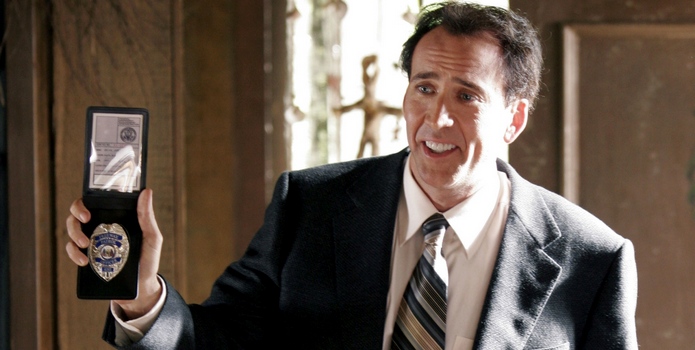
“I only care about the law, Sister.” – actual quote from Edward Malus
He awakes from his nightmares and peers out the window to see a child (possibly Rowan?) running across a field and into the woods. He runs downstairs to pursue her and is led into an old barn. When he ascends to the loft, he only finds a red jacket matching those that all the young girls wear on Summer’s Isle. As he’s searching the jacket, the old, rotting floor falls out beneath him and he nearly drops to his death. The next morning at the inn, he expresses disbelief he’s being served store-bought honey when they harvest it on the island. Sister Beech explains last year’s crop was ‘curse.’ Further exploring the inn’s dining hall, Malus discovers a display of photos of young girls: princesses of the harvest throughout the years. But the last photo has gone missing, apparently ruined the previous night.The young Sister Honey (Leelee Sobieski) corners Malus on his way out of the inn to beg him to take her with him when he leaves the island.
Malus continues to search Summer’s Isle. He walks in on a class of girls about Rowan’s age in the one-room schoolhouse, taught by Sister Rose (Molly Parker) – they all have plant or farm-product names in Summer’s Isle. He’s taken aback by the class discussion of phallic symbols, but more alarmed by an empty desk. “Who’s desk is this?” he demands, but when he opens it, a crow flies out. (Malus mirrors the audience’s reaction with his “what?”) Though none of the students nor teacher claim to know a Rowan, Malus finds Rowan’s name on the school roster, crossed out, and accuses them all of lying. Sister Rose walks Malus outside to explain Rowan died, in an accident. A slip of Rose’s tongue has her say “she’ll burn to death,” instead of “she burned to death.” Rowan was buried in the old churchyard, Sister Rose says.
Obtaining directions to the churchyard from someone who looks eerily similar to Sister Rose, Malus finds Rowan’s tombstone outside church ruins. Willow finds him and claims Rowan isn’t buried below. Instead, she says that the villagers are punishing her for being too proud, for temporarily escaping the island. Teary-eyed, she reveals Rowan is Edward’s child (though I was pretty sure we already knew that). She shows him Rowan’s room, completely empty. Willow says she left for the market, and when she returned, a half-hour later, Rowan and all her things were completely gone. All she left behind are some disturbing drawings that Malus finds under her desk.
Malus hears the seaplane arriving, and runs to use its radio. When he arrives at the dock, Malus finds no sign of the pilot. So he waits patiently until he spies Rowan (or a girl who looks a lot like her) under the dock. He dives into the water, but when he reaches her drowned body, he awakes with a start. It was all a dream. He’s still sitting on the dock, but lying there in his arms: a drowned Rowan! Then he awakes from that nightmare. (It’s the elusive movie double-nightmare!) Back in reality, he gives up on waiting and swims to the seaplane, only to discover the radio in the plane has been totally dismantled.
On land, Malus pays a visit to Dr. Moss (Six Feet Under‘s Frances Conroy). Not only is she the village’s doctor, she’s official photographer of the harvest festival. She’s also mondo secretive about a book on her desk: Rituals of the Ancients. Malus waits until she leaves for the day, then promptly breaks into her house and office. Inside the book, he finds notes about blood rituals and how they affect fertility and the harvest. He also stumbles across a whole bunch of human fetuses in jars throughout her lab. Most damning of all, he finds a print of the photo of Rowan Woodward at the last harvest festival (now missing from the inn). It’s been editoriaized: “Worst. Harvest. Ever.”
As everyone else in Summer’s Isle continues to stymie Malus’s investigation, Willow and he begin to rekindle their old romance. While cycling around the island (there are no motor vehicles in sight), he cycles straight into a field of beehives, which is – if you remember My Girl at all – kind of a catastrophe for someone allergic to bees. Malus is promptly swarmed and passes out just as he reaches for his epi-pen. When he comes to, he’s being tended by Dr. Moss in the home of Sister Summersisle (Ellen Burstyn), de facto ruler of the island, clothed in a yellow tunic dress and saffron shawl.
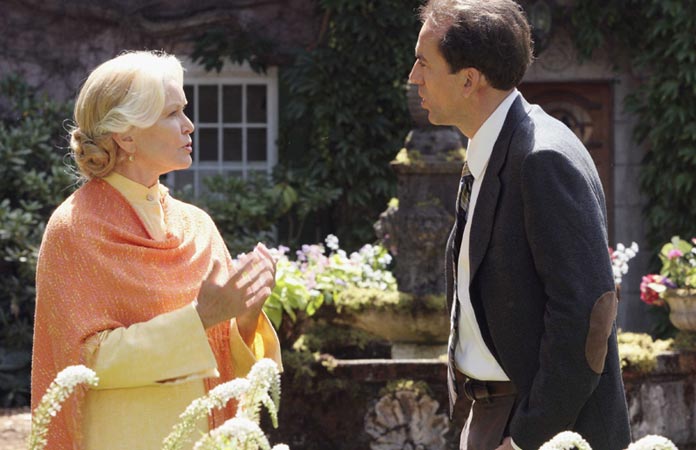
Sister Summersisle tries to explain to Edward Malus that feminism is for everyone.
Malus requests permission from Summersisle to exhume Rowan’s body from the churchyard. Summersisle insists murder is entirely absent from their community, and gives Malus a little history lesson on the community. Her ancestors were victims of the Salem Witch Trials, and the survivors eventually made their way to the west coast to separate from the rest of society. During her monologue, Summersisle leads Malus through serious bee territory, weaving in and out of hives, exposing him to mortal danger. When Malus expresses concern for the men in this matriarchal community, Summersisle says the men are not subservient to women. But Malus harbours his doubts.
Granted grave-digging privileges, Malus unearths Rowan’s coffin in the dead of night (when else?), but finds nothing inside but a burned doll. He hears crying from the church ruins; they seem to be coming from the locked crypt. He ventures inside and finds yet another red jacket (like Rowan had). He then dives into a flooded section of the crypt, swimming past a drowned statue of Jesus (pagan imagery?), when someone seals the entrance behind him. He’s locked in a flooded tomb!
Willow finds him the next morning and frees him from the crypt. Malus promptly dons his jacket (over a soaked dress shirt) and Cage goes into full manic mode. He badgers his ex-fiancee about the doll – “How did it get burned?!” – then rushes to Summersisle’s home, searching for his benevolent warden. He doesn’t find her, and instead finds (of all things) a one-eyed old man in her bed, as well as (in another room) a grinning, naked woman covered with bees. Sister Rose, dressed in a crow costume, bikes along on her way the a festival of death and life (or so she calls it). Malus commandeers her bicycle and makes his way to the inn to get help from the assembled men inside. His effort is futile, though; they won’t even look at him.
Malus has just about had it with this weird pagan murder town. He starts forcibly removing animal masks from children on their way to the festival. He returns to the dock only to find the seaplane submerged and the pilot dead and horribly mutilated. The bonkers atmosphere crescendoes to a fever pitch as Malus (largely unprovoked) punches Sister Beech in the face, then later roundhouses Sister Honey into the wall. He finds a bear suit and disguises himself as a villager, then runs to join the festival
Sister Summersisle, made up like Lokai and Bele from the original Star Trek, presides over the festival. The revellers dance (though there is very little music) and Summersisle presents their sacrifice: Rowan Woodward. A shofar player blasts a mighty toot and Rowan is tied to a stake. The bear in the crowd breaks free, punches the musician and rescues Rowan. Father and son escape into the woods with the angry revellers hot on their trail. Rowan takes the lead and Malus follows, then realizes too late that Rowan wasn’t the one who needed rescuing. She leads him straight back to the group, and asks Willow, “Did I do it right, Mommy?”
Malus pulls his gun on the crowd and Summersisle reveals their scheme. The entire island worked together to bring him there. (Even the mother and daughter in the burning car were Summer’s Isle locals.) And Rowan was never the sacrifice; he was. For a sacrifice, they need a stranger connected to the community by blood. And who better than Edward Malus, the father of Summersisle’s grandchild? (That’s right, Summersisle is Willow’s mother!) Willow then reveals she took the bullets from Malus’s gun, and the crowd swarms him, not unlike a certain insect.
What follows is a preparation for the sacrifice. The crowd hobbles him with a mallet, then places a sort of bee helmet on his head and pour a swarm of angry hornets inside (Most people are probably familiar with Malus’s reaction to this process.) They then epi-pen him back to consciousness, drag him to the massive Wicker Man structure – a towering wicker replica of a man – and light it on fire. In fact, Rowan takes the torch to light it herself. The crowd chants, “The drone must die” as Malus is engulfed in flames.

Nicolas Cage, demonstrating improper use of a beekeeper’s mask.
Takeaway points:
- Having now seen both the original and remade The Wicker Man, I am obsessed with the significant differences. The original highlighted the officer’s puritanical hang-ups – as a proper Christian he was disturbed by their pagan ways long before he realized he was to be their sacrifice. Malus is likewise disturbed by the community at Summer’s Isle, but there’s no religious basis to his unease. The subtext of the original was that the officer was a virgin sacrifice (which also explained his unease with the freewheeling pagans and all their talk of phallic symbols and nude dancing). Given that Rowan is Malus’s daughter in the remake, the new version obviously scrapped that aspect. (Perhaps they figured no one would conceivably buy Nicolas Cage as a virgin.)
- Additionally, the pagan island society in the new version is a lot less fun. In the original, the islanders sing and dance (often while naked), play games. They sing a rousing song at the finale while the officer burns alive – a scene far more disturbing than the “drone must die” chanting in this version. The 1973 Wicker Man is practically a musical! But it also highlights why one might enjoy being part of this pagan cult: it looks kind of fun. Being one of the dour sisters in this Summer’s Isle looks like no fun at all, and instead paints the pagans as more puritanical than the police officer, which makes almost nosense in the logic of the film.
- At one point during the screening of The Wicker Man, I turned to our host, Lindsay, and asked, “Was this movie written by a men’s rights activist?” If we were (again) to sum up the theme of The Wicker Man as a hashtag, it would be #misandry. Cherry-picking from the theme of puritanical thought vs. pagan liberation that ran through the original, the opposition in the remake seems to be between Malus’s logical masculinity (his last name is literally a portmanteau of “man” and “phallus”) and Sister Summersisle’s (and the whole village’s) pagan femininity. And the film suggests that Summersisle is in the wrong – and not just because she’s a murderer! The unease with the feminine runs through The Wicker Man. Only the girl children are educated. Men in this matriarchal society are unable to act on their own – unable to even speak. When Malus runs to the inn for help, he yells at the assembled men to join him, but they’re so emasculated by life in Summer’s Isle, they won’t even raise their eyes. This would explain all the women-punching that happens in the film. The villagers call Malus a “drone” (bees without stingers, whose sole purpose is to mate), and, in the finale, remove the bullets from his gun. (Get it?) Yet this film is from Neil Labute, whose earlier films (like In the Company of Men) seemed to investigate misogyny with a critical eye. So, the question remains: is this depiction of a murderous, dangerous feminism for real? Or is it tongue-in-cheek? Intentionally over-the-top?
- Nic Cage’s manic performance must also be discussed, and not only because it’s made the movie something of a cult classic (and possibly the only reason you may have heard of The Wicker Man). Why does Cage chew the scenery like a man denied artisanal honey his entire life? One possible answer is that he (and possibly the director Labute) see the film as a bizarre comedy. That the idea of feminism or a matriarchal society being any real threat to the current order or even the very existence life of men is so ludicrous, it can only be laughed at. Is that giving the makers of The Wicker Man too much credit?
- The movie is dedicated to Johnny Ramone. Which is confusing to say the least. But a routine internet search reveals that Ramone and Nicolas Cage were friends, and Ramone introduced the actor to the original Wicker Man.
Truly terrifying or truly terrible?: It’s terrible. But it’s also terribly entertaining. (Not very scary, though.)
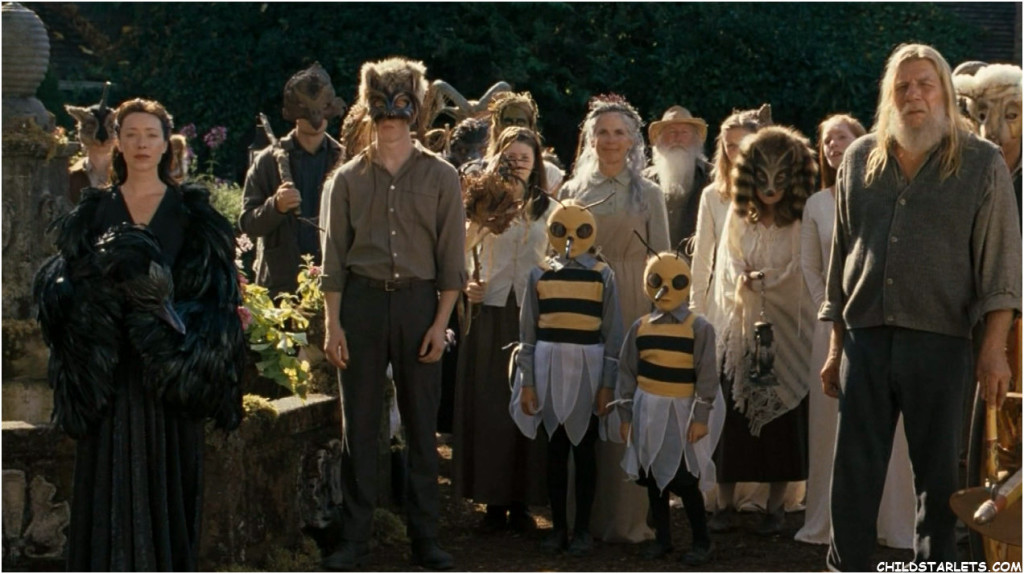
Tell me you can’t envision those bee costumes on the runways of Milan.
Best outfit:Malus’s navy suit with brown elbow patches gets full marks. It’s very fashion-forward for a cop, and he wears it in nearly all circumstances, whether he be digging graves or going for a swim. However, the real winners of the fashion show are the kids wearing outstanding bee outfits during the final costume party / pagan death ritual.
Best line: It’s hard to choose just one. Should it be, upon seeing villagers carrying a wriggling, bloody bag, Malus asking, “What’s in the bag? A shark or something?” Or Malus ranting, “How’d it get burned?!” I have to go with a time-honoured classic: Malus, captured by the villagers and about to be hobbled, shouting, “Bitches! You bitches! This is murder! You’ll all be guilty! And you’re doing it for nothing! KILLING ME WON’T BRING BACK YOUR GODDAMN HONEY!”
Best kill: Malus’s powerful kick that sends Sister Honey flying into a wall of framed portraits is tremendous, but she (amazingly) doesn’t die as a result. If your movie is called The Wicker Man, the death inside the Wicker Man is probably going to be the best kill. And Malus’s death has it all: a difficult-to-watch Misery-like hobbling, a face full of bees, and our hero burning alive.
Unexpected cameo: The movie features some great character actors in smaller roles, but nothing can compare to the sight of a young James Franco, in an unfortunate post-credit sequence, being seduced by Sister Honey and a friend in a decidedly not-Summersislian bar. Franco, a recent graduate from the police academy, is to be one of the next victims of the Wicker Man.
Unexpected lesson learned: Sadly, I think the lesson the makers of the film want us to learn is something backward about feminism (see the takeaway points), but the real lesson is to always use the buddy system when infiltrating a cloistered pagan community.
Most suitable band name derived from the movie: Sister Summersisle.
Next up: Pet Sematary (1989).

